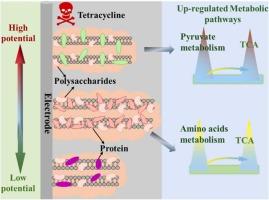电活性生物膜通过改变EPS结构和代谢途径来感知电位和四环素
IF 11.3
1区 环境科学与生态学
Q1 ENGINEERING, ENVIRONMENTAL
引用次数: 0
摘要
细胞外聚合物(EPS)的分泌决定了微生物电子传递的效率和对毒性挑战的抵抗力。电极电位是影响电子转移速率和方向的关键因素。然而,电位调控EPS结构和毒性物质去除的机制尚不清楚。本研究提示,正电位升高可刺激细胞外蛋白和多糖(PS)分泌增加。但PS分泌过多限制了电流输出,-0.1 V时的极限电流是0.3 V时的1.39倍。正电位使EAB的蛋白质结构更加紧凑,但四环素(TC)的加入破坏了EAB的多肽结构,而α-螺旋和α-螺旋/β-片在-0.1 V下优于其他电位。在-0.1 V下,EABs对TC的毒性反应保持了更高的Geobacter(86%)和细胞活性。在这个电位下观察到的降解率是高电位下的1.5倍,主要是由于氨基酸代谢途径的上调。本研究证明了利用电极电位调节EPS平衡进行电子转移和自我保护的潜力,为通过电极电位操纵胞外聚合物分泌来增强污染物的生物修复提供了理论支持。本文章由计算机程序翻译,如有差异,请以英文原文为准。

Electroactive biofilms alter the EPS structure and metabolic pathways to sense potential and tetracycline
The extracellular polymeric substances (EPS) secretion decides the efficiency of microbial electron transfer and the resistance to toxic challenges. Electrode potential is a critical factor affecting both the rate and direction of electron transfer. However, the mechanism through which potential regulates EPS structure and toxic substance removal remains unclear. This research suggested that more positive potential stimulated increased extracellular protein and polysaccharides (PS) secretion. Nonetheless, excessive PS secretion restricted the current output, with the limiting current at −0.1 V being 1.39 times that of 0.3 V. A positive potential resulted in a more compact protein structure, but tetracycline (TC) addition has disrupted the polypeptide structure of EAB, while the α-helix and α-helix/β-sheet at −0.1 V was superior to other potentials. Under −0.1 V, the EABs maintained more abundant Geobacter (86 %) and cellular activity when sensing to the toxic of TC. The degradation rates observed at this potential was 1.5 times that of high potential, largely due to the upregulation of amino acid metabolic pathways. This study demonstrates the potential of using electrode potential to regulate the balance of EPS for electron transfer and self-protection, providing theoretical support for manipulating extracellular polymer secretion through electrode potential to enhance bioremediation of pollutants.
求助全文
通过发布文献求助,成功后即可免费获取论文全文。
去求助
来源期刊

Journal of Hazardous Materials
工程技术-工程:环境
CiteScore
25.40
自引率
5.90%
发文量
3059
审稿时长
58 days
期刊介绍:
The Journal of Hazardous Materials serves as a global platform for promoting cutting-edge research in the field of Environmental Science and Engineering. Our publication features a wide range of articles, including full-length research papers, review articles, and perspectives, with the aim of enhancing our understanding of the dangers and risks associated with various materials concerning public health and the environment. It is important to note that the term "environmental contaminants" refers specifically to substances that pose hazardous effects through contamination, while excluding those that do not have such impacts on the environment or human health. Moreover, we emphasize the distinction between wastes and hazardous materials in order to provide further clarity on the scope of the journal. We have a keen interest in exploring specific compounds and microbial agents that have adverse effects on the environment.
 求助内容:
求助内容: 应助结果提醒方式:
应助结果提醒方式:


